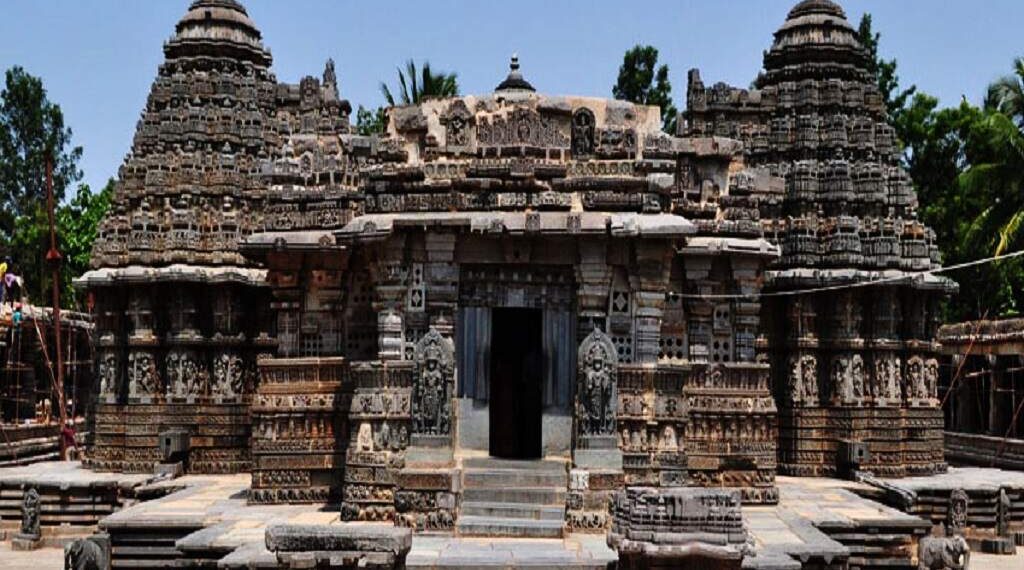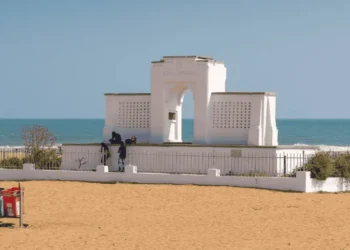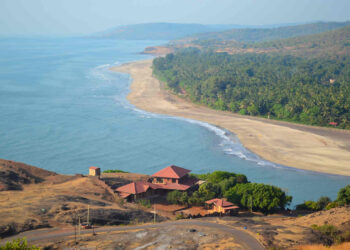The Hoysaleswara Temple is a holy kshetra for Lord Shiva, worshipped as Hoysaleswara, located in Halebidu, Karnataka, about 220 km from Bengaluru and 30 km from Hassan. Constructed in the 12th-century, the temple sits near the Dwarasamudra lake, and is a pinnacle of Hoysala architecture. The temple is also a UNESCO tentative World Heritage Site covering around 5 acres, with intricate carvings, twin sanctums, and quiet courtyards. The temple stands as a proud emblem of Karnataka’s spiritual and artistic legacy.
Legend of the Temple
There are various legends about the Hoysaleswara Temple. One story tells of King Vishnuvardhana, a Hoysala ruler. He built the temple around 1121 CE dedicating to Lord Shiva after his victories over neighboring kingdoms. Guided by his devotion, he named it Hoysaleswara, linking it to his title “Hoysala.” The temple’s carvings show Shiva’s tales, like his cosmic dance as Nataraja or his fight with terrible demons, reflecting his valor and divine power.
Another tale speaks of a divine call. Vishnuvardhana, inspired by a vision of Shiva, chose Halebidu, a sacred spot by the lake, to build this grand shrine. Artisans, led by master sculptor Kedaroja, worked for decades, resulting in today’s marvel.
History of Hoysaleswara Temple
The Hoysaleswara Temple’s story starts in the 12th century. Old Hoysala writings say it was a big Shiva temple, though it is said that devotees might have prayed in Halebidu even before that. The temple took about 80 years to build, starting around 1121 CE with King Vishnuvardhana. His family, like Narasimha I and Ballala II, kept adding to it. Hoysala records and Shiva books call it a special holy place.
The Hoysala kings, ruling from the 11th to 14th centuries, were its main supporters. Stone carvings show Vishnuvardhana gave land, gold, and oil for lamps to keep the priests and prayers going. By the 12th century, it was a busy spot, with craftsmen, traders, and farmers helping out, as village papers say. The Vijayanagara kings, from the 14th to 16th centuries, looked after it, building new halls and fixing carvings. The Wodeyars of Mysuru, in the 17th century, repaired parts hurt by rain and wind.
In the 14th century, northern invaders came and damaged some carvings, but priests hid the temple’s idols to keep them safe. The Vijayanagara kings later brought back the old ways. In the 1700s, the Marathas held Halebidu for a short time, then the British took over in 1800. The temple stayed strong. By 1856, the British were in charge, and in 1947, Karnataka’s government took over, with the HR&CE Board running it now. The temple’s holy history lives in old writings and songs by saints like Allama Prabhu, whose Shiva hymns show its deep faith. It’s still a big Saiva Kshetra today.
Architecture of the Temple
The Hoysaleswara Temple, built in the classic Hoysala style, covers about 5 acres in Halebidu. It doesn’t have a big gopuram, but simple doorways lead to a star-shaped platform holding two holy sanctums for Lord Shiva—one called Hoysaleswara and the other Ishwara, named to honor Queen Shantala Devi, King Vishnuvardhana’s wife. Inside each sanctum, there’s a lingam, carefully carved to feel sacred. Close by, a small shrine for Shantala as a form of Parvati has a calm, warm feel.
The temple’s outer walls are like a storybook, with over 1,000 detailed carvings. About 200 big panels show gods, singers, and animals, proving the Hoysala craftsmen’s talent. The main hall, called the Mukha Mandapa, has 60 pillars, each one scratched with scenes from the Ramayana and Mahabharata, making you stop and stare. Around the bottom, five rows of carvings—elephants, fighters, flowers, strange beasts, and dancers—run for about 180 meters, sharing old tales. A holy pond, the Chandra Pushkarini, sits in the courtyard. Little shrines for Ganesha, Kartikeya, and Vishnu are spread around. Some carvings, fixed up by the Wodeyars in the 1600s, show Hoysala soldiers and palace life, making every corner a peek into the past.
Festivals
Festivals bring the temple to life like Maha Shivaratri, in February or March, which fills it with night-long prayers until sunrise. People sing Shiva’s praises, light oil lamps, and bathe in the Dwarasamudra lake nearby, feeling his presence. In April, the Sapthotsava goes on for seven days, with priests chanting ancient hymns and carrying Shiva’s idol through Halebidu’s lanes in a lively procession, with folks playing drums and blowing flutes. Songs by saints like Basavanna, tied to Saiva devotion, shape Karnataka’s Bhakti ways. Festivals bring Carnatic music and Bharatanatyam, keeping arts alive, and the carvings show Hoysala life. The temple’s lakeside setting, near Belur’s Chennakeshava Temple, ties it to Karnataka’s past as a craft hub.
Today, the temple draws people from all over. Halebidu is 220 km from Bengaluru or 30 km from Hassan, and you can get there by bus or train without much trouble. The temple links Karnataka’s old days with now, holding faith, art, and history. Stories like Vishnuvardhana’s vision or the artisans’ skill live in local folk songs and family tales.
Conclusion
The Hoysaleswara Temple embodies tale of holy roots, its history with old kings and tough times, its intricate stone carvings, and the unmatchable presence of Lord Shiva make it a special place. The Hoysaleswara Temple calls thousands of people who pray to Shiva, coming from all over India, filling its grounds with their love and devotion.











